|
A Short History and Dedication, by Hanno Spoelstra |
|
| Editor's Note: Please click on photos for larger versions as well as detailed captions of the Dedication ceremony. | |
| The Origins | |
| Shortly after D-Day it was found that an armoured fighting vehicle, preferably tracked, should be employed for carrying Infantry into battle. Thus, long, fatiguing approach marches and unnecessary casualties could be avoided. The answer was found in the Kangaroo, a vehicle capable of going wherever the tanks could go and of giving adequate protection to the infantry right up to the objective. | 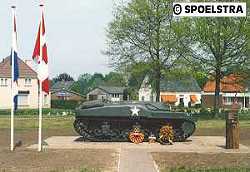
|
| The first Kangaroos, known as Unfrocked Priests or Priest Kangaroos, were improvised by taking the gun out of U.S. Priest M7 105mm Howitzer Motor Carriages and thus providing room for 20 infantry plus a crew of one. The Priests had become surplus to requirements when they were superceded by the Canadian-built Sexton 25pdr SP Gun. | |
| Before any organising or training could take place, these vehicles and their drivers went into action at the Falaise Gap. Because this experiment proved a great success, the Kangaroo Squadron was organised on 26 August 1944. The Squadron was attached to the 25th Canadian Armoured Regiment (The Elgin Regiment) for administrative purposes only. The Elgin Regiment was under First Canadian Army control and the Kangaroo Squadron was an Army asset which could be employed by various units according to the operations being undertaken. The commanding officer of the Squadron was Lieutenant-Colonel G.M. Churchill who had been DCO of the Elgins. He was to remain as CO throughout the war. | |
| The Squadron was first employed against Le Havre during Operation Astonia on 2 September 1944 while working with the 51st Highland Division. This action was quickly followed by assaults on Boulogne on 17 September and Calais on the 25th. These first organised actions were highly successful, as the infantry reached all their objectives speedily while suffering only one casualty during the Le Havre action. | 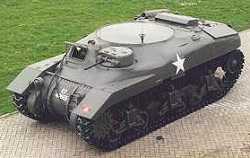
|
| A Military Medal was earned at Calais by a Canadian Corporal who captured a German Tiger tank with his un-armed Kangaroo. He was able to surprise the Tiger and ram it, after which it toppled over and the German crew was captured. | |
| Introduction of the Ram Kangaroo | |
| When the Priests had to be returned to the U.S. Army, they were replaced by modified Ram Cruiser Tanks, which had up to this point been sitting in a depot in Britain. With their turrets removed the Rams proved suitable for their new role. The infantry still had to disembark over the side, but they were much lower than the Priests. Although the Ram Kangaroos were uneconomical in that they only held a section of infantry (8 soldiers and a driver and commander/ wireless operator), they covered the ground to the objectives speedily, gave cover to the infantry on the way and were able to fight their way forward under the fire of their own .30 calibre hull-mounted machine-gun. | |
| At Rouen, France, the first Ram Kangaroos replaced the Priest Kangaroos. | 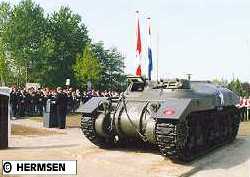
|
| The Kangaroos go to Holland | |
| he Kangaroo Squadron, newly equipped and refitted with 16 Ram Kangaroos for each of its four troops, continued on the long journey from France through Belgium and then by transporter to Mill in Holland. Here the Squadron came under command of the Second British Army which was then engaged in clearing the enemy from the territory West of Venlo and Roermond. | |
| Rehearsals were carried out with various units and many lessons were learned in the co-operation of all arms. However, the plan was changed before the Squadron became involved. The clearing of the approaches to the Port of Antwerp was considered to be of greater strategical value at this time and so the Kangaroo Squadron was moved West to play a part in that operation. | |
| The first action on Dutch soil was against the heavily defended Dutch city of 's-Hertogenbosch on the 23 October 1944. Following this the Squadron was used continuously, assaulting Schilburg, St.Michiels-gestel, Boxtel, Esch, Moergestel, Tilburg, Kaatsheuvel, Waspik, Waspik-Boven, Raamsdonk and Laan. After its first two months of its existence, the Squadron had some thirty "lifts" to its credit when it was released from action and regrouped at Tilburg. | |

|
|
| The Formation of the 1st Canadian Armoured Carrier Regiment | |
| As 21st Army Group was impressed by the performance of Kangaroo-mounted infantry in the break-out of Normandy, it was decided to form a regiment of Kangaroos within each of the two Armies under command. Consequently, on 24 October 1944, First Canadian Army authorised the formation of the 1st Canadian Armoured Carrier Regiment. As the core of this new Regiment - the personnel and the vehicles of the Kangaroo Squadron - were at Tilburg, this town was selected as the point for concentration. November and December were spent in organising and the Regiment was brought up to strength in personnel and vehicles. Each of the two squadrons of the Regiment had 53 Ram Kangaroos divided over their four troops. Its personnel were drawn from all units of the Canadian Armoured Corps and some from artillery formations. Every province and every Military District had its quota of representatives. These diverse elements with their scattered loyalties were moulded together to form a coherent unit of high morale. | |
| The crews carried a bronze-metal cap badge, designed by the C.O., on their black berets: an erect Kangaroo above the device ARMATOS FUNDIT, loosely translated as "Bearing Armed Men". Shoulder patches had "ARMD CARRIER REGT Canada" embroidered in orange on black felt. The colour orange was specifically chosen because the Regiment was the first and last formed in Holland. As there was no time to officially request a cap badge at the Canadian General Staff, an order for badges was directly placed in England and they were delivered before the end of the year. In December 1944, the decision was made to include the Regiment, together with the British 49th Armoured Personnel Carrier Regiment, within the ranks of the British 79th Armoured Division. The 1st Canadian Armoured Carrier Regiment earned the distinction of being the only Canadian formation in this famous assault Division. | 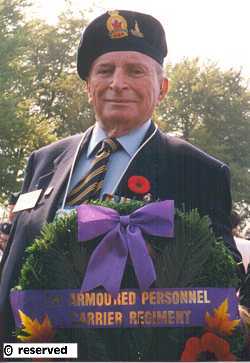
Half a century ago, Trooper Arthur Bell was a member of TAC HQ, 1st Canadian Armoured Carrier Regiment. Although in his 70s, one can hardly call this proud Canadian veteran an 'elderly person'. I have had the pleasure to meet Art in person, of which I have fond memories. While meeting him and other veterans after the ceremony, I noticed they were very thankful for their welcome in Holland. |
| The Regiment's Contribution to Final Victory | |
| During January 1945 the Regiment came into action in the province of Limburg. From Sittard assaults were made against Susteren, Baakenhoven, Dieteren, Oud Roosteren, Echt and Schilberg. Eastwards to Koningsbosch, Steaten, Erpen and into Germany: Uetterath, Dremmen and Heinsberg. These operations were carried out under the most trying conditions. Wintery weather and stiff German opposition took their toll and tested the endurance to the limit. But the Regiment was to be the first Canadian Regiment to be entirely within Germany. | |
| During February 1945 the Regiment came into action for Operation Veritable, the clearing of German Army between the Maas and the Rhine rivers. The Regiment moved off from Nijmegen into Germany. During 29 days of fighting the Regiment took part on attacks on Kranenburg, Frasselt, Schottheide, Bresserberg, Kleve, Moyland, Hasselt, the road to Veen and finally Xanten. Again, despite appalling conditions and desperate German opposition, the job was done. Another "first" was scored when the Regiment was the first Canadian regiment to cross the Siegfried line. | |
| Following a short rest, the Regiment was again called in action for Operation Plunder in March. The Regiment was the first Canadian Armoured formation to cross the Rhine on the 26 of March, 1945. Attacks went in on the Dutch towns of Millingen, Megchelen, Landfort, Ruurlo, Borculo, Barchem, Lochem, Haarle, Assen, Hooghalen, Rolde, Balloo, Loon and Groningen. From there an advance was made into Germany where the last lift was made at 0700 hours of the fifth of May, 1945. The advance made that morning was one of some seven miles North and East of Oldenburg, Germany. It ended with the complete surrender of an entire Austrian Infantry Battalion, without a single shot being fired. | 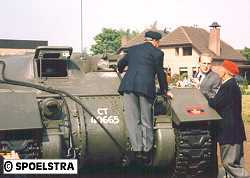
|
| A few days later the Regiment gathered in a concentration area at Penheim, Germany. On the 20th of June at 2359 hours the Regiment was formally disbanded and the last full parade of the unit was held, after which the personnel went back to their original regiments, were seconded to other formations, or went home. | |
| Concluding, it can be said that during the Allied drive through France, Belgium, Holland and into Germany the Regiment played an important role. Soldiers of 38 British and 20 Canadian regiments were carried into battle. Sadly, the casualties of the Regiment included 17 killed and 71 wounded. | |
|
|
|
| Source: The History of the Kangaroos: 1st Canadian Armoured Carrier Regiment, 1945. | |
|
|
|
| Text and photos Copyright © 1999, H.L. Spoelstra / Sherman Register / All Rights Reserved | |
|
|
|

Click here to jump to the Kangaroos' Home Page! |
|
|
|
|
| Click HERE to return to the Canadian Armoured Corps | |
| Click HERE to jump to the Kangaroo Restoration pages | |
| Click HERE to return to the History section | |
|
|
|
| Page Copyright © Geoff Winnington-Ball , 1999-2000 - All Rights Reserved | |